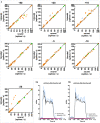Audiotactile interactions in the mouse cochlear nucleus
- PMID: 33767295
- PMCID: PMC7994829
- DOI: 10.1038/s41598-021-86236-9
Audiotactile interactions in the mouse cochlear nucleus
Abstract
Multisensory integration of auditory and tactile information occurs already at the level of the cochlear nucleus. Rodents use their whiskers for tactile perception to guide them in their exploration of the world. As nocturnal animals with relatively poor vision, audiotactile interactions are of great importance for this species. Here, the influence of whisker deflections on sound-evoked spiking in the cochlear nucleus was investigated in vivo in anesthetized mice. Multichannel, silicon-probe electrophysiological recordings were obtained from both the dorsal and ventral cochlear nucleus. Whisker deflections evoked an increased spiking activity in fusiform cells of the dorsal cochlear nucleus and t-stellate cells in ventral cochlear nucleus, whereas bushy cells in the ventral cochlear nucleus showed a more variable response. The response to broadband noise stimulation increased in fusiform cells and primary-like bushy cells when the sound stimulation was preceded (~ 20 ms) by whisker stimulation. Multi-sensory integration of auditory and whisker input can thus occur already in this early brainstem nucleus, emphasizing the importance of early integration of auditory and somatosensory information.
Conflict of interest statement
The authors declare no competing interests.
Figures






References
-
- Young ED, Oertel D. The synaptic organization of the brain. Oxford: Oxford University Press; 2004.
MeSH terms
LinkOut - more resources
Full Text Sources
Other Literature Sources
Research Materials

